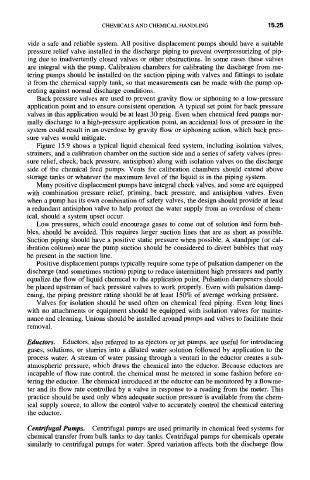Page 518 -
P. 518
CHEMICALS AND CHEMICAL HANDLING 15.25
vide a safe and reliable system. All positive displacement pumps should have a suitable
pressure relief valve installed in the discharge piping to prevent overpressurizing of pip-
ing due to inadvertently closed valves or other obstructions. In some cases these valves
are integral with the pump. Calibration chambers for calibrating the discharge from me-
tering pumps should be installed on the suction piping with valves and fittings to isolate
it from the chemical supply tank, so that measurements can be made with the pump op-
erating against normal discharge conditions.
Back pressure valves are used to prevent gravity flow or siphoning to a low-pressure
application point and to ensure consistent operation. A typical set point for back pressure
valves in this application would be at least 30 psig. Even when chemical feed pumps nor-
mally discharge to a high-pressure application point, an accidental loss of pressure in the
system could result in an overdose by gravity flow or siphoning action, which back pres-
sure valves would mitigate.
Figure 15.9 shows a typical liquid chemical feed system, including isolation valves,
strainers, and a calibration chamber on the suction side and a series of safety valves (pres-
sure relief, check, back pressure, antisiphon) along with isolation valves on the discharge
side of the chemical feed pumps. Vents for calibration chambers should extend above
storage tanks or whatever the maximum level of the liquid is in the piping system.
Many positive displacement pumps have integral check valves, and some are equipped
with combination pressure relief, priming, back pressure, and antisiph0n valves. Even
when a pump has its own combination of safety valves, the design should provide at least
a redundant antisiphon valve to help protect the water supply from an overdose of chem-
ical, should a system upset occur.
Low pressures, which could encourage gases to come out of solution and form bub-
bles, should be avoided. This requires larger suction lines that are as short as possible.
Suction piping should have a positive static pressure when possible. A standpipe (or cal-
ibration column) near the pump suction should be considered to divert bubbles that may
be present in the suction line.
Positive displacement pumps typically require some type of pulsation dampener on the
discharge (and sometimes suction) piping to reduce intermittent high pressures and partly
equalize the flow of liquid chemical to the application point. Pulsation dampeners should
be placed upstream of back pressure valves to work properly. Even with pulsation damp-
ening, the piping pressure rating should be at least 150% of average working pressure.
Valves for isolation should be used often on chemical feed piping. Even long lines
with no attachments or equipment should be equipped with isolation valves for mainte-
nance and cleaning. Unions should be installed around pumps and valves to facilitate their
removal.
Eductors. Eductors, also referred to as ejectors or jet pumps, are useful for introducing
gases, solutions, or slurries into a diluted water solution followed by application to the
process water. A stream of water passing through a venturi in the eductor creates a sub-
atmospheric pressure, which draws the chemical into the eductor. Because eductors are
incapable of flow rate control, the chemical must be metered in some fashion before en-
tering the eductor. The chemical introduced at the eductor can be monitored by a flowme-
ter and its flow rate controlled by a valve in response to a reading from the meter. This
practice should be used only when adequate suction pressure is available from the chem-
ical supply source, to allow the control valve to accurately control the chemical entering
the eductor.
Centrifugal Pumps. Centrifugal pumps are used primarily in chemical feed systems for
chemical transfer from bulk tanks to day tanks. Centrifugal pumps for chemicals operate
similarly to centrifugal pumps for water. Speed variation affects both the discharge flow

